Inpatient census 2017: parts one and two
Results of the third Mental Health & Learning Disability Inpatient Bed Census and Out of Scotland NHS Placements Census, 2017.
2. Adult patients treated in NHS Scotland facilities (additional detail)
- There were 3,535 patients aged 18 and over at the March 2017 Census
- 87% of adult patients received a physical examination, on admission or an annual physical health check
- 1,478 patients aged 18+ (42%) were seen by a consultant whose specialty was 'General Psychiatry'. A further 1,329 (38%) were under 'Psychiatry of Old Age'.
Specialty of Consultant
NHS Boards were asked to record the specialty of every consultant who was responsible for overseeing the treatment of each patient in the Census. A total of 1,478 (42%) patients aged 18+ were seen by a consultant whose speciality was ‘ General Psychiatry’. A further 1,329 (38%) patients aged 18+ came under ‘Psychiatry of Old Age’. More details can be found in figure 7.
Figure 7: Number of patients (aged 18+) by consultant speciality, March 2017 Census
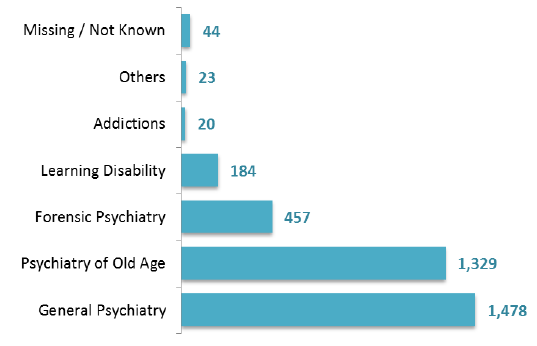
Length of stay in hospital
There has been little change in the ‘days since admission’ across the three Censuses for adults aged 18+. The average (median) length of time has been around 5 months, see table 7.
Table 7: Average (median) length of stay for each Census, adults aged 18+
| Length of Stay |
October 2014 |
March 2016 |
March 2017 |
|---|---|---|---|
| Average (Median) Days |
163 |
150 |
161 |
| Average (Median) Banded |
~ 5 months |
~ 5 months |
~ 5 months |
Figure 8 details a further breakdown for the March 2017 Census. It shows a wide spread in the length of time a patient aged 18+ has spent in hospital. Most patients (24%) have spent between 1 and 5 years in hospital, while 13% have spent over 5 years and 5% less than 72 hours.
Figure 8: Days since admission, banded (adults, aged 18+), March 2017 Census
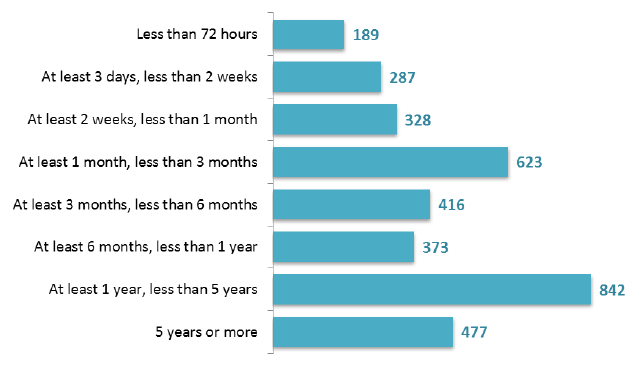
The average (median) number of days since admission for patients with a Learning Disability was 730 days (around 2 years). This compares with 133 days (around 4 months) for non-Learning Disability patients. These figures show a decrease of 29 days on average (median) in hospital for Learning Disability patients compared to 2016, while for non-Learning Disability patients there was a 4 day increase.
Living Circumstances
NHS Boards were asked to record the ‘Living Circumstances’ from a range of pre-defined options for each patient recorded in the Census. A total of 1,377 patients aged 18+ (39%) were in a Hospital or other medical establishment, while 626 (18%) were under Local Authority tenancy. See figure 9 for more details.
Figure 9: Number of patients (aged 18+), by living arrangements, March 2017 Census
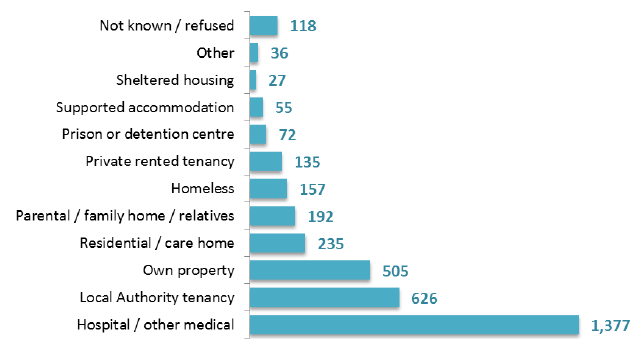
Employment Status
Of the 3,283 (93%) patients aged 18+ for whom employment status was known at the March 2017 Census, 1,591 (48%) were unemployed, 1,399 (43%) were retired, 117 (4%) were not allowed to work and 112 (3%) were in employment.
Status
Patients who have been detained under the provisions of the Mental Health (Care and Treatment) (Scotland) Act of 2003 are defined as having ‘Formal’ status. ‘Informal’ refers to voluntary Mental Health admissions.
Of those adult patients in the March 2017 Census, 1,640 (46%) were admitted with a ‘Formal’ status, while 1,895 were admitted with an ‘Informal’ status. On the date of the Census, 1,657 (47%) had ‘Formal’ status, and 1,878 had an ‘Informal’ status.
Other Legislation
NHS Boards returned data on a range of legislation for which patients were subject to at the 2017 Census date. A total of 958 patients aged 18+ (30% of known cases) were subject to the Adults with incapacity (Scotland) Act 2000. 911 patients (29%) were subject to the Mental Health Act (Compulsory Treatment Order). Data was missing for 372 patients. See figure 10 for more details.
Figure 10: Number of patients (aged 18+), subject to legislation, March 2017 Census
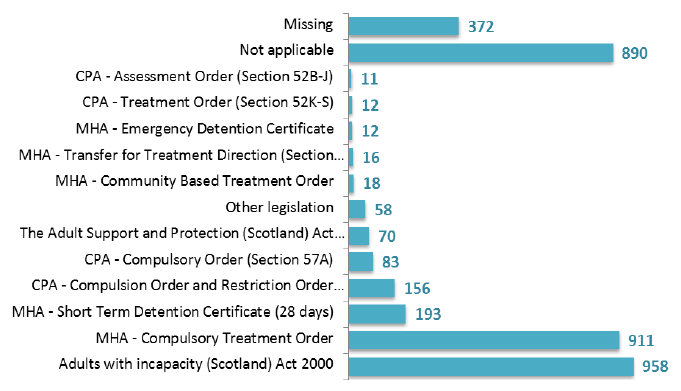
* Patients can be subject to multiple pieces of legislation
** MHA - Mental Health Act
*** CPA - Criminal Procedure Act
Health and Wellbeing
The following sections consider the mental and physical health of all patients aged 18+ at the 2017 Census.
Mental health morbidities
NHS Boards were asked to return diagnosis codes ( ICD 10) for any mental health condition for which patients in the 2017 Census had a diagnosis. A total of 2,764 (80%) patients aged 18+ with a known diagnosis had only one mental health condition recorded, while 682 (20%) had a diagnosis for 2 or more condition. There were 89 patients with either no diagnosis yet or an unknown diagnosis. See figure 11 for more details.
Figure 11: Number of patients (aged 18+), by number of mental health conditions ( ICD 10 codes), March 2017 Census
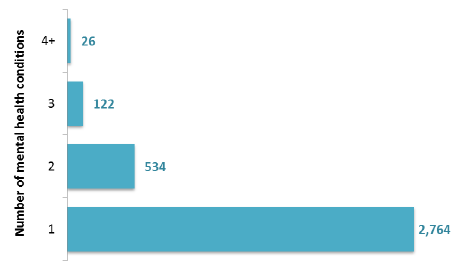
* No diagnosis yet or unknown diagnosis for 89 patients
Figure 12 presents the most commonly diagnosed mental health morbidities, as at the 2017 Census date for adults aged 18 or over. These are based on ICD 10 codes and include primary as well as secondary diagnoses. In addition, separate questions on Autistic Spectrum Disorder and Personality Disorders allowed for cross-comparison with ICD 10 codes to pick up any patients missing these ICD 10 codes.
The two most common diagnoses are Dementia (1,000 patients) and Schizophrenia (977 patients), which each account for around 28% of all adult patients in the Census. Patients with a Personality Disorder accounted for 10% of the 2017 Census. It should be noted that a patient may have more than one diagnosis.
Figure 12: Number of patients (aged 18+), by mental health diagnosis, March 2017 Census
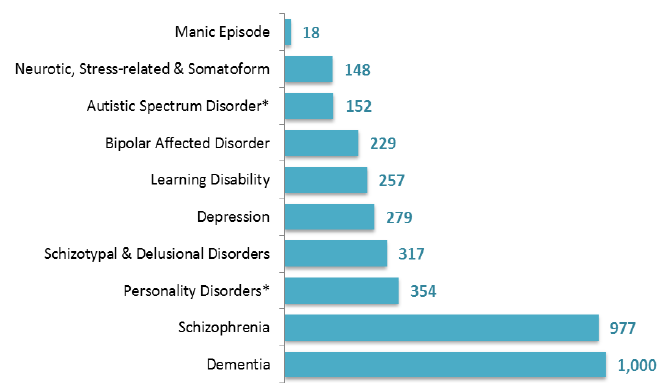
* All mental health diagnoses are based on ICD 10 codes. Primary and secondary diagnoses included
* Personality Disorders and Autistic Spectrum Disorder counts also rely on respective questions on these disorders
* Patients may have more than one diagnosis
Learning Disabilities and Autism
Of the 3,535 patients aged 18+ at the 2017 Census, 335 (9%) patients had a diagnosis for either a Learning Disability or Autism, while 257 (7%) patients had a diagnosis for a Learning Disability, 152 (4%) patients had a diagnosis for Autism (74 patients had a diagnosis for both).
Physical health co-morbidities
The Mental Health Strategy 2017 – 2027 emphasised the importance of considering physical health along with mental health and how the outcomes of both are linked. A key outcome from the 2014 Census was the need to improve the recording of both mental and physical health morbidities. Mental Health and Learning Disability services in NHS Boards are working towards routinely recording physical health conditions under the International Classification of Diseases. The 2016 Census included a suite of Yes/No physical health questions and these were retained for the 2017 Census. Physical health information was returned for all except one adult patient.
List of yes/no physical health morbidities questions in the Census:
● Hypertension,
● Dyslipidaemia,
● Coronary heart Disease,
● Epilepsy,
● Chronic Kidney Disease,
● Thyroid Disease,
● Cancer,
● Alcohol Acquired Brain Injury,
● Diabetes,
● Chronic Obstructive Pulmonary Disease,
● Chronic Pain,
● Sensory Impairment,
● Liver Disease,
● Acquired Brain Injury,
● Strok e / Transient Ischaemic Attack,
● Parkinson
A total of 2,059 patients aged 18+ (58%) had at least one physical health co-morbidity based on the suite of Yes/No physical health questions as at the 2017 Census. This is higher than the 53% figure reported in 2016. See figure 13 for more details.
Figure 13: Number of patients (aged 18+), by number of physical conditions (based on suite of Yes/No questions), March 2017 Census
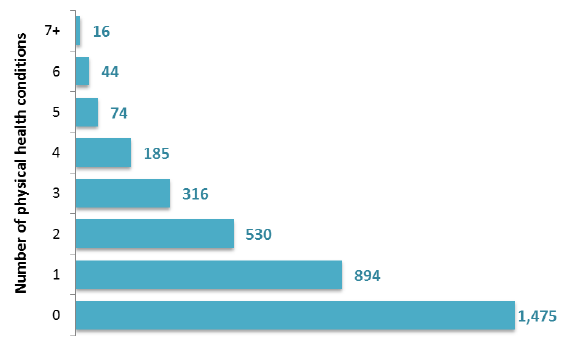
* 1 patient had no physical health information returned
Figure 14 shows a breakdown of the number of patients aged 18+ for each physical condition as asked in the suite of Yes/No questions. Of all the adult patients in the 2017 Census, 17% had hypertension, with 85% of these patients being on anti-hypertensive medicines. The next most prevalent physical health condition was sensory impairment, with 16% of patients reported as having this condition.
Figure 14: Number of patients (aged 18+), by physical condition (based on suite of Yes/No questions), March 2017 Census
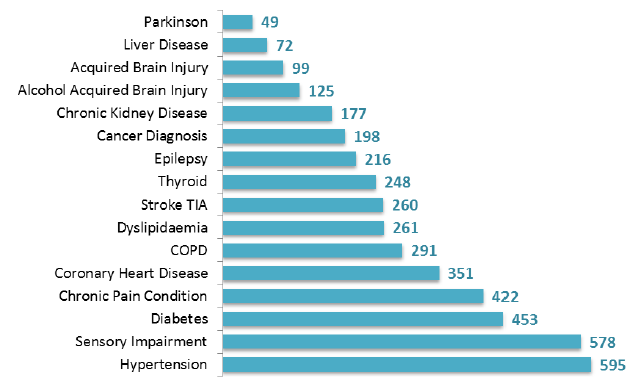
* Patients can have more than one physical condition
Physical Health Check
The 2017 Census included, for the first time, questions related to physical health checks. These follow on from actions on mental health set out by the Chief Medical Officer ( http://www.sehd.scot.nhs.uk/cmo/CMO(2015)19.PDF). There were two questions;
- For patients admitted to a mental health bed between the 1 st April 2016 and 30 th March 2017: Did the patient receive a general physical examination by a qualified clinician within a day of admission?
- For patients admitted to a mental health bed prior to the 1 st April 2016: Has the patient had an annual (physical) check within the last year? An annual health check should be both a physical assessment and delivery of health promotion activity.
There were 2,213 (63% of all) patients aged 18+ who were admitted between 1 st April 2016 and the 30 th March 2017. Of these, 1,972 (89%) had a general physical examination within a day of admission. A further 41 (2%) were offered but declined. See figure 15 for more details.
Figure 15: Number of patients (aged 18+), general physical examination, March 2017 Census
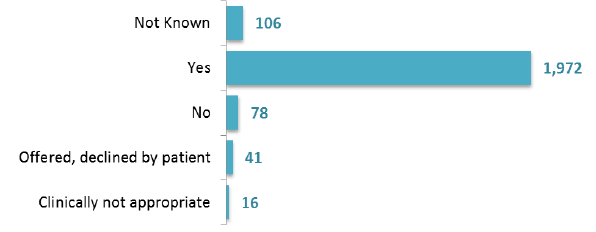
There were 1,322 (37% of all) patients aged 18+ who were admitted prior to the 1 st April 2016. Of these, 1,090 (82%) had received a physical health check within the last year. A further 49 (4%) were offered but declined. An annual physical health check was clinically not appropriate for a small number of patients who have been grouped with the not known patients for patient confidentiality. See figure 16 for more details.
Figure 16: Number of patients (aged 18+), annual physical health check, March 2017 Census
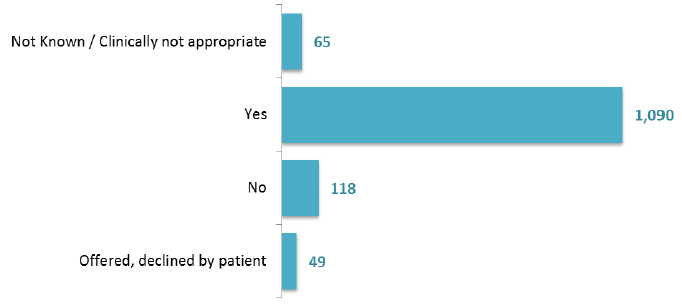
Overall in the 2017 Census, a total of 3,062 (87%) of patients received some form of physical health check, while a further 90 (3%) were offered.
Lifestyle factors
BMI (Body Mass Index)
BMI (Body Mass Index) was calculated for patients whom height and weight information was returned. A total of 186 (5%) patients were excluded because height and weight information was either not provided, were extreme outliers or the patient was in an Eating Disorder ward. Of those patients included, 1,227 (37%) had a normal BMI, while 58% were overweight or obese. See figure 17 for more details.
Figure 17: Number of patients (aged 18+), by BMI Index, March 2017 Census
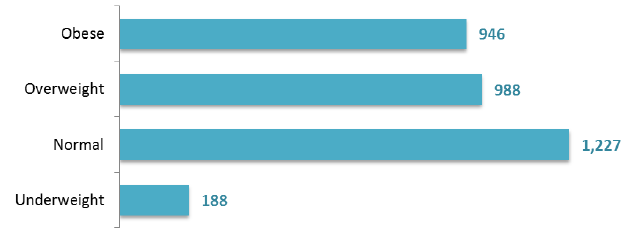
Smoking, alcohol and drug misuse
The 2017 Census included a number of questions around alcohol and other substance misuse. It is known that not all patients with alcohol dependence or substance abuse will have a formal ( ICD 10) diagnosis. This section contains analysis of patients with alcohol dependence and / or substance misuse based on responses for a combination of questions. A minor methodological change was made in 2017 (see Section 6 for further detail).
A total of 1,171 (33%) patients aged 18+ smoked tobacco in the 12 weeks prior to the Census date. In the 2016 Census, this figure was 35%.
In the 2017 Census, 684 (19%) of patients had a dependence on alcohol / harmfully used alcohol, of which 181 (26%) had an alcohol related diagnosis based on ICD 10 codes. In 2016, the proportion of patients with a dependence on alcohol / harmfully used alcohol was also 19%.
A total of 613 (17%) of adult patients had abused substances (excluding alcohol). Of these, 185 (30%) had a diagnosis of drug misuse based on ICD 10 codes. Both proportions are similar to those reported in 2016.
Figure 18: Number of patients (aged 18+), smoking, drugs and alcohol, March 2017 Census
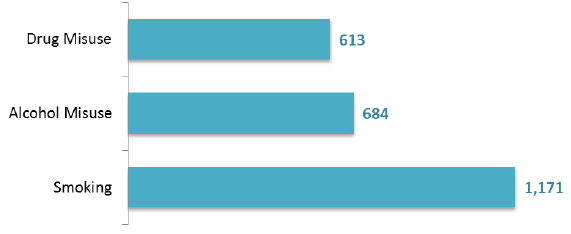
Substances used prior to admission
For the March 2017 Census, NHS Boards were asked to record the substances which patients used prior to admission.
For those patients who did have a record of substance abuse (excluding alcohol) in the four weeks prior to admission (539 known patients), cannabis was the most prevalent with 301 (56% of known patients) recorded as having used it. Amphetamine was the second most prevalent, with 97 (18%) of patients recorded as having used it. See figure 19 for more details of selected substances.
Figure 19: Number of patients (aged 18+), substances used four weeks prior to admission, March 2017 Census
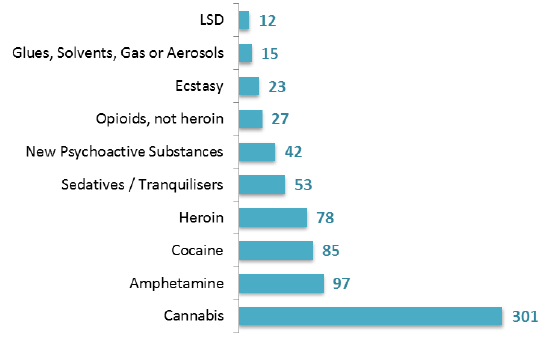
* Patients can be in more than one category
* Does not include all substances
Of the 539 patients with a record of substance abuse (excluding alcohol) in the four weeks prior to admission, 316 (59%) patients used only one substance, while 144 (27%) used two or more. Detailed information on substances used was not returned for 79 patients. See table 8 for more details.
Table 8: Number of patients, by number of substances used, by Census
| Number of substances used per patient in 4 weeks prior to admission |
March 2016 |
March 2017 |
||
|---|---|---|---|---|
| One |
291 |
57% |
316 |
59% |
| Two |
79 |
15% |
70 |
13% |
| Three |
41 |
8% |
34 |
6% |
| Four |
19 |
4% |
16 |
3% |
| Five or more |
13 |
3% |
24 |
4% |
| Not known |
72 |
14% |
79 |
15% |
Of the patients with recorded substance abuse in 4 weeks prior to admission, 290 (54%) used smoke or nasal as the main route of substance abuse, 190 (35%) oral and 35 (6%) injecting (patients can use more than one route).
Self-harm
NHS Boards are asked to return information on whether patients self-harmed in the week prior to admission. In the 2017 Census, this was known for 3,222 (91%) of adult patients. Of these, 350 (11%) patients self-harmed in the week prior to admission. A total of 222 (63%) of these patients self-harmed by non-accidental injury. See figure 20 for more details.
Figure 20: Number of patients (aged 18+), by method of self-harm, March 2017 Census
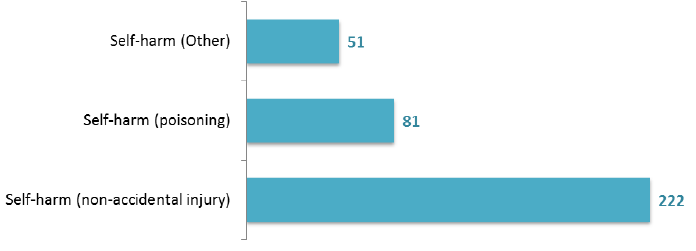
* Patients can be in multiple categories
Suicidal ideation
NHS Boards are asked to return information on whether patients were expressing suicidal ideation on admission. This information was returned for 3,298 (93%) of patients. Of these, 405 (12%) expressed suicidal ideation on admission.
Contact
Email: Guy McGivern, SWStat@gov.scot
Phone: 0300 244 4000 – Central Enquiry Unit
The Scottish Government
St Andrew's House
Regent Road
Edinburgh
EH1 3DG
There is a problem
Thanks for your feedback